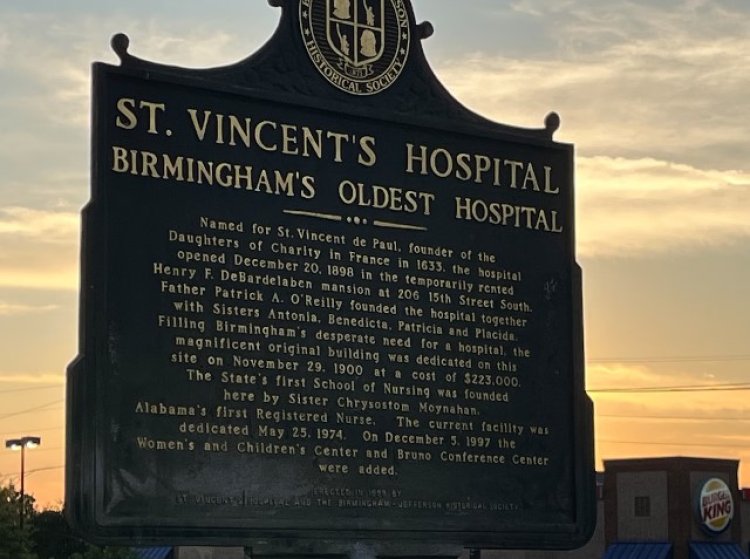UAB to Remove Religious Icons as It Acquires Birmingham's First Hospital, St. Vincent’s
Ascension-St. Vincent’s Hospital and the Catholic Diocese of Birmingham will collaborate this fall to remove all Catholic symbols, statues, and artifacts from Birmingham’s historic first hospital as UAB Hospital assumes ownership.

Ascension-St. Vincent’s Hospital and the Catholic Diocese of Birmingham will collaborate this fall to remove all Catholic symbols, statues, and artifacts from Birmingham’s historic first hospital as UAB Hospital assumes ownership.
St. Vincent’s Hospital, established in 1898 by the Daughters of Charity at the invitation of St. Paul’s Cathedral Pastor Patrick O’Reilly, has been a cornerstone of Birmingham's healthcare since its founding. The hospital was created in response to the urgent need for medical care in Alabama’s rapidly growing industrial city.
In its early years, the hospital provided charity care for many patients suffering from smallpox, yellow fever, tuberculosis, and industrial accidents. The nuns even purchased the city’s first ambulance, further solidifying their commitment to serving the community.
For decades, the Daughters of Charity were not only the hospital's administrators and nurses but also ran a nursing school to train future caregivers. Sister Chrysostom Moynahan, the hospital’s first administrator, was also Alabama’s first registered nurse. Historic photos and displays commemorating the nuns' contributions are featured in the hospital’s lobby and other areas.
A statue of Pastor O’Reilly stands at the entrance of the main St. Vincent’s Hospital building, and the hospital’s elaborate chapel, located on the main level, boasts a large crucifix within a marble cross-shaped opening. Stained-glass windows depicting the Beatitudes adorn the chapel, and carved wooden representations of Jesus, Joseph, Mary, and various saints, including St. Vincent, are found throughout the hospital. Crucifixes are also present at many entranceways.
"We do have to remove the Catholic identity from those former buildings of St. Vincent’s that are now going to become UAB," said Rev. Bryan Jerabek, pastor of St. Paul’s Cathedral and chancellor of the Diocese of Birmingham.
As UAB prepares to acquire Ascension-St. Vincent’s properties in Alabama, the Catholic Diocese of Birmingham has been involved in discussions, with the transaction requiring approval from the Vatican, expected to be finalized in September or October. Jerabek anticipates the sale to be completed by October or November.
The Daughters of Charity and other religious orders owning Ascension Health have been gradually divesting their healthcare properties nationwide. Bishop Steven Raica, head of the Birmingham diocese, sent a letter to the Vatican recommending approval of the transaction, noting the end of Catholic-inspired healthcare in Birmingham with a sense of sadness.
St. Vincent’s Hospital, Birmingham’s first hospital, holds significant historical value, and UAB has expressed a desire to respect that history. Although UAB is not a Catholic institution, Jerabek believes it will continue the hospital’s tradition of charity work for the indigent and other community members in need.
The ornate chapel at St. Vincent’s will be converted into an interfaith chapel, necessitating the removal of the large crucifix and other Catholic artifacts, including a framed page from a Catholic missal dating back to the 1500s. The removal of Catholic imagery will be a delicate process, handled with care by the diocese and UAB to respect the space's new purpose.
This change will impact all St. Vincent’s properties, including satellite institutions in Chilton, St. Clair, Blount, and St. Vincent’s East in Jefferson County. The diocese will assist in removing Catholic symbols and ensuring the proper handling of sacred objects.
To honor the legacy of St. Vincent’s, the diocese will hold a closing liturgy, offering closure to employees and community members who have been connected to the hospital for years. The diocese’s full-time archivist, Caleb Hendrix, will document and preserve the hospital's historical artifacts.
The diocese is also open to future collaborations with UAB to keep the memory of St. Vincent’s alive, possibly through displays or exhibits. Jerabek emphasized the smooth transition between UAB and Ascension, highlighting both parties' openness and transparency. The diocese remains committed to honoring the past while looking forward with hope.







